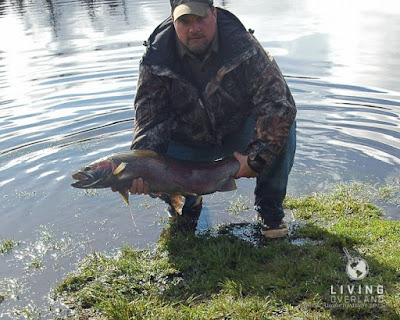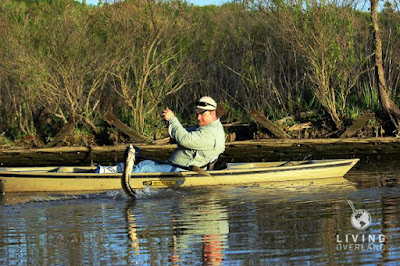How to Catch More Fish When on The Road
When I was a young man working at our local sporting goods store, a wise old salt gave me some profound advice. What he said all those years ago has stayed with me and has formed the way I have fished all over the country from Alaska to Florida. He said, “90% of the fish live in 10% of the water and 10% of the fisherman catch 90% of the fish caught.”
When we are traveling around North America exploring the quiet, less traveled roads we often find vistas of grand lakes and winding rivers. I would venture to say that most of us look down on these waters and even if only for a brief minute, the thought of fishing these waters cross our minds. Offshore saltwater fishing is a different beast, and we’ll leave that for another day. Today let’s look at how to fish these hidden gems of freshwater and brackish waters across the US.
When arriving at a new area, the best place to start is the local fishing shop. The guys or gals working there will be able to point you in the right direction concerning the type of fish locally available, the lures that are most effective, and maybe even some locations for the best fishing. In this situation, a paying customer will get a better response to his questions than someone who comes running into the store and starts right off asking questions.
I like to stop in the local fishing shop and start off with buying my fishing license. While in most states you can purchase it online, buying it at the store is a perfect conversation opener. I’ll start the conversation with a question that lets the store clerk know I have some fishing knowledge, just not of the area. Questions like, “I noticed that River XYZ is running a little muddy, how’s the trout been biting lately?” Or maybe, “I was thinking of trying Lake ZYX for some smallmouth bass, have the fish been deep or shallow these days?” General human nature being what it is, people like to talk about what they know. If you can get the clerk talking, he will give the local intel on what’s what with the local waters.
 The clerk will hopefully be able to direct you to the locally preferred lures. When I first arrived in Ketchikan Alaska, I struck up a conversation with a young guy at the store. He led me in the right direction with the correct jig size and color and even instructed me in how I should fish the lake. The next day I caught my first steelhead trout using the information he gave me. Arriving in southwest Florida, I stopped in at the bait shop next to my hotel and based on their information, I caught my first jack crevalle and snook the next day.
The clerk will hopefully be able to direct you to the locally preferred lures. When I first arrived in Ketchikan Alaska, I struck up a conversation with a young guy at the store. He led me in the right direction with the correct jig size and color and even instructed me in how I should fish the lake. The next day I caught my first steelhead trout using the information he gave me. Arriving in southwest Florida, I stopped in at the bait shop next to my hotel and based on their information, I caught my first jack crevalle and snook the next day.In both incidences, I let the local information lead me toward the type of fish I would pursue. What’s the old saying, “when in Rome, do as the Romans do”? Same is true with travel fishing, find what is biting at the time you are there and focus on that species. In a few months, I will be traveling through Canada fishing the lakes for large brook trout, but if I find the trout bite lacking and the pike readily available, then I’ll fish for pike.
One basic key to catching more fish is understanding how fish position themselves in the water. When dealing with a current flow, the fish will face into the current waiting for food to drift pass. When fishing a river, I will cast up river and swim the bait with the current pass the likely fish holding spots. When dealing with inshore saltwater fishing, tide movement is key to catching fish. A section of water can appear empty of fish until the tide starts to flow, at which time the dinner bell rings and the fish readily feed on almost anything you toss in the water.
So how does all of this information come together? Well, later this year when I embark on a long trip exploring Canada and the US, and I plan to take with me two seven feet long spinning rods. One will be a light action and the other a medium / heavy action rod. With those two rods, I can effectively fish anywhere across the continent. Rods and reel selection does not have to break the bank, but equipment of low quality will hinder one’s fishing ability. As a price point, a good rod and reel combo will cost between $100 and $200.
Now that we have spent some time talking about where to fish and the types of rods/reels I plan on using on my upcoming trip, lets talk about what to put at the end of the line. Despite the endless amounts of lures and jigs that can be found in sporting goods stores, I feel there are four primary lures one should consider.

- Classic Inline Spinner. A size #1 or #2 Mepps spinner will catch trout, bass, and panfish in any moving water situation like a creek or river. In general, the copper-colored blade works better in cloudy, muddy water and the silver works better on bright sunny days and clear water. If I had only one, it would be a silver blade.
- Floating Minnow Jerk-Baits. Again, I tend to go to the original 3 ½ inch or 5 ¼ inches floating Rapala with a silver body and black back. This minnow imitation will catch just about any fish eager to eat as well as trigger a reaction bite when aggressively twitched on the retrieve. Yo-Zuri lures also make a high quality floating Crystal Minnow that is weighted for better casting, and I have been using this one lately.

- Soft Plastic Baits. The third bait used to slow down your fishing by pitching to specific weedy pockets looking for hiding game fish would be a white four or five-inch fluke soft plastic bait or something similar. I also like to use a 5 inch Senko style plastic worm in a brown or purple color. With whatever style of soft plastic bait you choose, local knowledge will help dictate the best color choice. White or purple are always good bets to start.

- Hair Jig/Bucktail. A 3/8 or ½ oz sized bucktail in either white or chartreuse can be fished either deep bouncing off the bottom or with a slightly faster swimming retrieve. I have even used a fast retrieve skipping a bucktail along the surface to catch topwater busting chain pickerel.

Walking down to the lake and tossing a nightcrawler on a hook out into the lake, sitting on your cooler after opening your favorite beverage and waiting for a bite may be an enjoyable way to pass an afternoon, but is not very productive when it comes to catching fish. To be one of the 10% catching 90% of the fish is not difficult. It just takes a little effort and basic fishing know-how. Enjoy the pursuit of finding the fish using a basic understanding of where fish congregate and what they want to eat.
Andrew Aughenbaugh enjoys traveling North America with a fishing rod, kayak paddle or gun in hand. Andrew finds the adventure in the journey and not the trophies collected. His writing and photography often reflects on the personal interaction with the natural world and living life through experiences.
Andrew’s articles and photographs have appeared in several national magazines to include North American Whitetail, Wildfowl, JP Magazine, Mid-Atlantic Game and Fish, North American Hunter, Chesapeake Angler, Low-Range Magazine, Huntingnet.com, Sportsmen Channel Magazine.
When Andrew returned from a summer in Alaska working as an off-road adventure guide in 2012, he created his own blog website, Augie’s Adventures.com. Augie’s Adventures covers a broad spectrum of outdoor topics embracing overlanding and vehicle builds, fishing, hunting, kayaking, canoeing, camping and just getting out and enjoying nature.
Andrew’s articles and photographs have appeared in several national magazines to include North American Whitetail, Wildfowl, JP Magazine, Mid-Atlantic Game and Fish, North American Hunter, Chesapeake Angler, Low-Range Magazine, Huntingnet.com, Sportsmen Channel Magazine.
When Andrew returned from a summer in Alaska working as an off-road adventure guide in 2012, he created his own blog website, Augie’s Adventures.com. Augie’s Adventures covers a broad spectrum of outdoor topics embracing overlanding and vehicle builds, fishing, hunting, kayaking, canoeing, camping and just getting out and enjoying nature.
___________________________
If you found this article helpful, please consider using one of the affiliate links below. The price is the same for you, but a small percentage of the purchase price goes to us, which helps keep this site going. Thank you!





